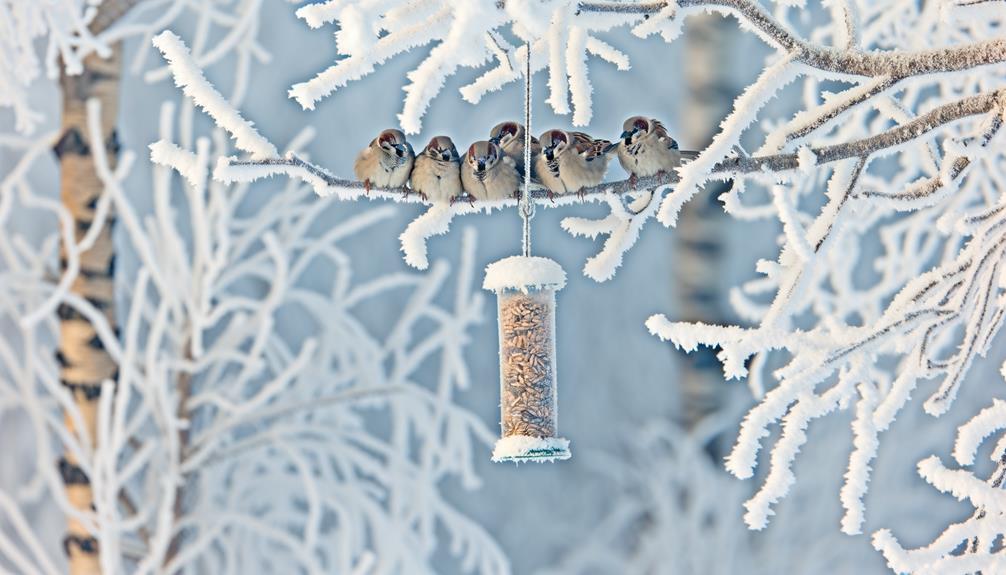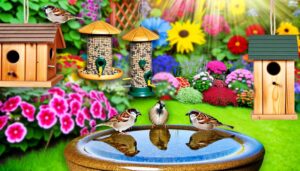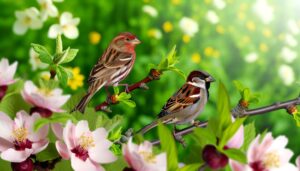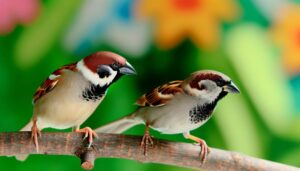How Do House Sparrows Survive Winter?
House sparrows survive winter through intricate social behaviors, such as communal roosting, which elevates roost temperatures by up to 10°C above ambient conditions. Their dietary flexibility allows them to consume a variety of high-energy foods, essential for maintaining metabolic rates.
Urban environments offer increased food availability, microclimatic warmth, and reduced predation, enhancing survival odds. Diverse nesting strategies provide protection from harsh weather and predators, with urban cavities often preferred for nest construction.
Feather insulation, metabolic adjustments, and shivering thermogenesis are vital for thermal regulation. These multifaceted survival strategies guarantee their resilience through winter months, revealing a sophisticated adaptation mechanism.

Key Takeaways
- House sparrows utilize communal roosting to share warmth, making roosts up to 10°C warmer than ambient conditions.
- Dietary flexibility allows house sparrows to consume high-energy foods such as seeds, grains, and anthropogenic sources.
- Urban environments provide increased food sources, warmth from buildings, and shelter, enhancing their winter survival.
- Feather insulation and shivering thermogenesis help house sparrows maintain body heat during cold temperatures.
- Flocking behavior minimizes energy expenditure and improves foraging efficiency, crucial for winter survival.
Social Behaviors
The social behaviors of house sparrows (Passer domesticus) during winter months are characterized by intricate flocking patterns and communal roosting, which play a critical role in their survival and thermoregulation.
Empirical studies indicate that these birds form flocks ranging from small groups of 10 to large aggregations exceeding 100 individuals. This flocking behavior facilitates foraging efficiency and predator avoidance.
Communal roosting, often in dense vegetation or human structures, notably aids in conserving body heat, with roost temperatures documented to be up to 10°C warmer than ambient conditions.
Data suggest that such social structures are integral to minimizing energy expenditure during cold nights, highlighting the adaptive significance of these behaviors in mitigating winter mortality rates among house sparrows.
Dietary Adaptations
Frequently displaying remarkable dietary flexibility, house sparrows (Passer domesticus) have developed a range of foraging strategies to exploit various food sources available during the winter months. Their winter diet includes seeds, grains, and various anthropogenic food items, reflecting their ability to adapt to fluctuating availability. This dietary diversity is essential for maintaining metabolic rates in colder temperatures. Observational studies indicate that house sparrows preferentially consume high-energy foods to sustain their thermoregulation needs.
| Food Source | Nutritional Value | Frequency of Consumption |
|---|---|---|
| Seeds | High in carbohydrates | High |
| Grains | Moderate energy | Medium |
| Insects | Protein-rich | Low |
| Anthropogenic foods | Variable | High |
This data underscores the significance of dietary adaptations in the winter survival of house sparrows.
Urban Environments
Urban environments provide a unique ecological niche that influences the behavior, physiology, and survival strategies of house sparrows. These birds have adapted to exploit the resources and conditions available in cities, which differ markedly from rural areas.
Studies indicate that urban house sparrows benefit from:
- Increased food availability: Waste and human-provided food sources sustain sparrows through the winter months.
- Microclimatic warmth: Buildings and infrastructure generate heat, reducing the thermal stress on sparrows.
- Reduced predation pressure: Urban areas often harbor fewer natural predators compared to rural settings.
- Shelter opportunities: Man-made structures offer numerous roosting sites that protect sparrows from harsh weather conditions.
These factors collectively enhance the winter survival rates of house sparrows in urban landscapes, showcasing their remarkable adaptability.
Nesting Strategies
House sparrows exhibit diverse nesting strategies that optimize reproductive success and offspring survival in varying environments. They commonly select nesting sites that offer protection from predators and harsh weather conditions. Data indicate that urban sparrows prefer cavities in buildings, while rural counterparts often utilize tree hollows or dense shrubbery.
Nest construction involves materials such as grasses, feathers, and paper, enhancing insulation and structural integrity. Studies have shown that nests positioned in sheltered locations exhibit higher survival rates, particularly during inclement weather.
Additionally, house sparrows demonstrate site fidelity, frequently reusing successful nesting sites. This behavior not only conserves energy but also capitalizes on previously tested safe environments, increasing the likelihood of reproductive success across seasons.
Thermal Regulation
Thermal regulation in house sparrows involves a combination of behavioral adaptations and physiological mechanisms to maintain body temperature within ideal ranges during winter months. These small passerines demonstrate remarkable resilience through several strategies:
- Feather Insulation: Increased plumage density provides enhanced thermal insulation.
- Roosting Behavior: Sparrows congregate in sheltered locations, reducing heat loss through communal warmth.
- Metabolic Rate Adjustment: Elevation of basal metabolic rate increases internal heat production.
- Shivering Thermogenesis: Involuntary muscle contractions generate additional body heat.
Field studies indicate that sparrows can endure temperatures as low as -10°C by employing these adaptations. Data suggests that feather insulation alone can reduce heat loss by up to 30%.
Understanding these mechanisms offers insight into the broader survival strategies of avian species in temperate climates.
Conclusion
House sparrows exhibit remarkable adaptability to winter conditions through social behaviors, dietary adjustments, and exploitation of urban environments. Nesting strategies and thermal regulation further enhance their survival.
An intriguing statistic reveals that house sparrows can reduce metabolic rates by approximately 30% during colder months, conserving energy efficiently. These multifaceted survival strategies underscore the species' resilience and adaptability, ensuring their persistence in diverse and challenging environments.
Understanding these mechanisms is essential for avian ecological studies and conservation efforts.






